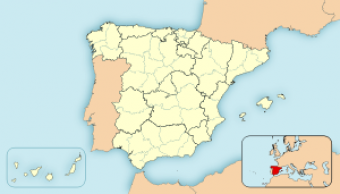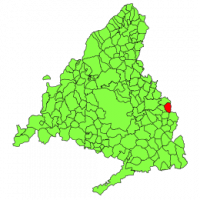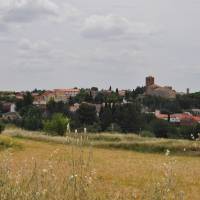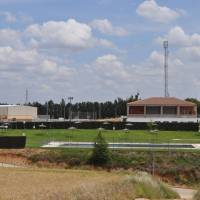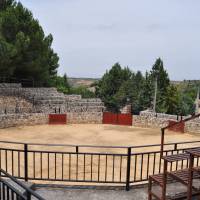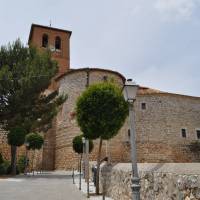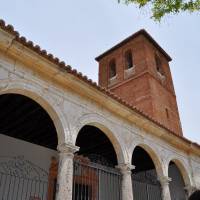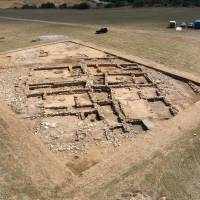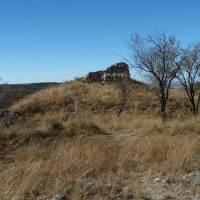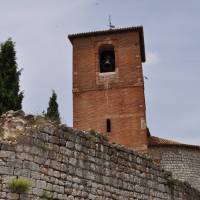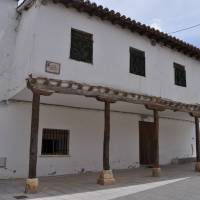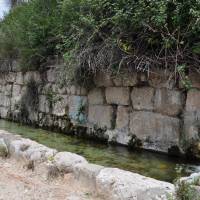Table of Contents
SANTORCAZ
Location of the Municipality
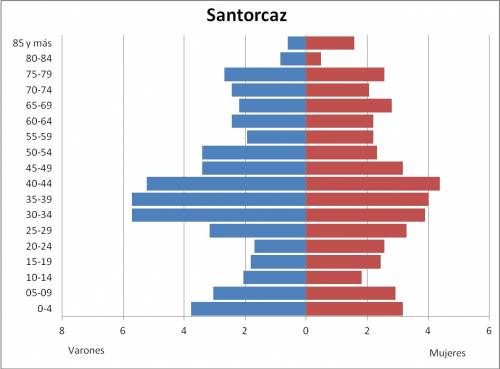 Situado en un paraje de Campiñas al este de la Comunidad de Madrid, conocido como La Alcarria de Madrid. El municipio se encuentra ubicado sobre el páramo de la Alcarria.
Situado en un paraje de Campiñas al este de la Comunidad de Madrid, conocido como La Alcarria de Madrid. El municipio se encuentra ubicado sobre el páramo de la Alcarria.
It Belongs to the judicial Alcalá de Henares, the countryside of County Henares, Madrid province.
Neighboring Municipalities
North: Los Santos de La Humosa
West: Anchuelo
East: Pioz and Pozo de Guadalajara
South: Corpa and Pezuela de Las Torres
Geographic Data
Area: 28,14 Km²
Altitude: 878 m
Latitude: 40°28’ 29’ ’’N
Longitude: 3°13’48’’ O
Resources Catalog
Natural Resources
| Name | Classification | Description | Other Observations |
|---|---|---|---|
| Livestock trails | Livestock trails | Five branches Santorcaz track to start from all directions. We communicate with Anchuelo, Corpa, y Pioz (Guadalajara). | |
| Mount “Santorcaz Station” | Reserved and protected Mount: Mount managed | This is land or scrubland mount located on the Monitoring Station Marina, east of the municipality. | Total Area: 185 ha. |
| Pinegrove of the pasture | Places, places of natural interest traditionally valued | It has been conditioned as a recreation area with benches and tables. | |
| Fauna | Fauna and ornithology | Foxes, hares, rabbits, partridges, wild boars, wild cats, booted eagles, owls, owls, hawks, kestrels and kites. | Endangered Birds: eagle. Birds are sensitive to habitat disturbance, little bustard and golden eagle. Threatened by the Regional Catalog: Montagu's harrier, peregrine falcon and owl. |
| Hunting | Huntin g | Abundant small game in the city | partridge, rabbit. |
Cultural Resources
| Name | Classification | Description | Other Observations |
|---|---|---|---|
| Church of Saint Torcuato | RTPP Religious Culture: Properties. | The building of the thirteenth century Romanesque tradition but humble masonry based building with rows of brick, which together with its triple-header Mudejar apse, makes it one of the finest examples of Moorish architecture in Madrid. The rest of the church is from the sixteenth and seventeenth centuries, even after the collapse of much of the building in 1951 had to be built in many ways. The porch was built in 1614. Contains a baroque altarpiece (S. XVII). | In the style of many scattered mainly in the north and east of the province of Madrid. Highlights the main apse, high-volume, which took as one of the units of the fortified defense. Inside you can admire paintings come out of the workshop of Juan de Arellano, a native of the village. |
| Hermita of the loneliness | RTPP Religious Culture: Properties. | Square building built in 1681 on an ancient shrine that existed in 1575. | |
| Hermitage of Orcalez | RTPP Religious Culture: Properties. | Early sixteenth century. Erected at the expense of an archdeacon of the Cathedral of Toledo, possibly on the ruins of a mosque. Rectangular with an apse, contains gothic elements. | Is currently under reconstruction. Located at the foot of the hill of the Watchtower Arabic. The Orcalez Virgin is the patroness of the villa. |
| Altarpiece of the Church Saint Torcuato | RTPP Religious Culture: Not Properties. | Baroque altarpiece, the mid-seventeenth century, which contains four canvases of the painter Francisco Camilo. | |
| Village Carpetano del Llano de la Horca | RTPP Cultural and Civil: Properties. | The Llano de la Horca is a reservoir of the Second Iron Age that was inhabited between centuries III and a.C. by Carpetan, pre-Roman people of the Iberian Peninsula, south of the Celts, which extended over the territories which now occupies almost the entire Community of Madrid and Castilla-La Mancha. The village has a footprint of about 10 hectares and its catchment area would be between 5 and 7 km. | They have also appeared coins, plates decorated, brooches, carders, arrowheads, pottery numerous fragmented (pots and storage jars), fusayolas, millstones, tweezers and needles of bone and bronze. The objectives of the archaeological project started in 2001 include the creation of an archaeological park near the urban enclave Santorcaz, which would facilitate their management. |
| The Castle of Torremocha | RTPP Cultural, Military: Real Estate. | Raised in the last third of the fourteenth century by Archbishop Pedro Tenorio, who built another castle on the previous one does not have any reference documents. The floor of the enclosure is oval, being the only southern right side. Its walls are articulated in plans that fit the edge of the platform on which it is located. In some of its angles are available towers. Its dimensions are 110 meters from north to south and 90 meters from east to west. His canvases, currently topped, have an average thickness of 1.6 meters. In addition there is a walled castle of seven towers are preserved differently bill have been built at different times. | During the fourteenth and fifteenth centuries the Archbishop of Toledo building control and strengthen defenses against the various vicissitudes of history, hence the different gear types that have the towers of the castle grounds. During the government of Archbishop Carrillo (1445-1482), the castle, which until then had been the residence of the archbishops palace, prison became clerics, their stays through eminent personalities like Cardinal Cisneros and princess of Eboli and others . On the other hand include the church of San Torcuato, apparently associated with the founding of the castle, which is attached to the canvas from the wall and one of its towers. Is owned by the City Council. |
| Santorcaz Tower of (Arabic watchtower) | RTPP Cultural and Civil: Properties. | Tower Arab Emirate time (centuries IX and X). Formed by a small fortress rectangular tower of which is just over five feet tall in one of its sides and angles. Around it has found abundant ceramic Arabic. | Is free, take M-213 road that leads to Santorcaz Anchuelo, and before reaching the latter town, is on our left the abandoned chapel of Our Lady of Hortaleza, stands beside the mountain called Cuesta of the turret on which the tower sits. |
| Facade of the Hospital of the Poor | RTPP Civil Cultural: Properties. | In 1627 they built the facade of one of the 2 buildings of poor Hospital, founded in the early sixteenth century. The cover was funded by the estate of a deceased person in the village. | |
| Laundries | RTPP Civil Cultural: Properties. | They were built in the late nineteenth century and have recently been restored. | Cross M-213 to access them. |
| Sources | RTPP Civil Cultural: Properties. | The fountain in the Plaza of the Constitution of 1919. Of the five sources in the sixteenth century, only the original known as Caño Alto, outskirts of the village. | |
| Bullring | RTPP Civil Cultural: Properties. | Pretty small stone bullring, which uses the slope where it is located, to place the stands. | It is situated beneath the apse of the Church of San Torcuato, forming a picturesque landscape. Significant potential for all kinds of events in addition to the bull. |
| Typical Meals | Folklore Gourmet | Candy: repápalos, bagels and toast. Pisto. | |
| Filming of “Crónicas de un pueblo” | Popular historic events | “Crónicas de un pueblo”, Antonio Mercero series filmed for Spanish TV, told the daily life and problems of the people of Castile, Puebla Nueva del Rey Sancho, fictional village since the series was actually recorded in Santorcaz, which brought fame to the town. | There is a village street called “Calle Spanish TV.” The series began airing in 1971 and spent three years on the air with great success. The series, devised by Admiral Carrero Blanco, was a strong ideological pro-regime. |
| Princess of Eboli | Historical Figures Relevant | Ana de Mendoza de la Cerda, Princess of Eboli, countess of Melito and Duchess of Pastrana, (Cifuentes, 1540 - Pastrana, 1592) was a Spanish aristocrat. The princess was imprisoned by Philip II in 1579, first in the Tower of Pinto, then the strength of Santorcaz and deprived of the custody of their children and manage their assets, to be transferred in 1581 to the Ducal Palace of Pastrana , where he died attended by his youngest daughter Ana de Silva. | He had conflicts with Teresa of Jesus, and participated in intrigues in the court of Philip II that cost him his imprisonment: After being widowed, legend has it that she became the mistress of King Philip II, although this has been denied by some authors, the after his secretary, Antonio Perez. Ana also said to be instigated by the secretary of the king's death in 1578 Juan de Escobedo, secretary of John of Austria and brother of the king, obtaining the consent of the king to convince him about alleged intrigues of Escobedo, who had actually discovered their affair with the king's secretary and surely denounced the monarch. |
| Cardenal Cisneros | Historical Figures Relevant | Francisco Jiménez de Cisneros whose name was Gonzalo better known as Cardinal Cisneros. After the death of his father gets the vicariate of Uceda, faced with the Archbishop of Toledo, which meant the imprisonment of Don Gonzalo Santorcaz by Archbishop Carrillo for some years. | Despite his imprisonment, Cisneros not resigned, which was held by Cardinal Gonzalez de Mendoza, but the closure was to last some time as it appears in some biographies, for soon after, in 1478, Cisneros was chaplain of the cathedral of Sigüenza. |
| The holiest Christ de la Fe | Celebrations | In September, for almost a week. Religious festivals and popular. On day 14 the Brotherhood celebrates Mass sung by a choir and procession of Christ accompanied by the band of the Paratrooper Brigade. 18 Day Mass in honor of the paratroopers who died in service, and tribute on the tombstone of the chapel of conception. Days 16 and 17 are held bulls (since 1619). | Also stresses the “rounds”, held at night to finish the dance. There are four: the single, that of married, singles and married. |
| Saint Antón | Celebrations | Night of January 16th. Neighbors gather at bonfires to burn objects in honor of the saint to protect animals, important for farm work | |
| Saint Roque | Celebrations | August 15. Pilgrimage to the hermitage of San Roque, where Mass is celebrated | |
| Auction of Bouquet | Celebrations | Ten days before Ash Wednesday. Collection is held among the residents, hunters go hunting and the women prepare threads. Everything is auctioned bound to the Church. | |
| Saint Torcuato and Saint Isidro | Patron Saint Festival | The May 15. It existed in 1583, and from 1627 and by order of Cardinal Gaspar de Quiroga, has been held in conjunction with San Isidro. Mass and procession in honor of San Torcuato. Bulls and bullfights, dancing and other activities. | |
| Virgin of Orcalez | Patron Saint Festival | September 8th. Been held since 1673. Image of the Virgin (the patron saint of the town) is taken in procession through the women of his Brotherhood. |
Tourist Services
| Name | Classification | Description | Other Observations |
|---|---|---|---|
| La Casona de Éboli | Hotels | Hotel Rural with 6 well-appointed rooms. SPA has. Make business meetings. | Funnel Street, 6 - Phones: 918 840 472 / 609 109 797 www.casonaeboli.com |
Other Services
| Name | Classification | Description | Other Observations |
|---|---|---|---|
| Gas Station of Robledal | Service Station | Urba. Avenue ,1 - Villalbilla - Phone: 918 859 967 | |
| Julio Muñoz Ranz | Service Station | El Gurugú, 28810 - Villalbilla - Phone: 918 834 122 |
Transports and Communications
| Name | Classification | Description | Other Observations |
|---|---|---|---|
| Line 275 | Bus | Alcalá de Henares - Los Santos de La Humosa - Alcalá de Henares | Monday to Friday 06:50am. to 21:30pm. |
| Saturday from 10:00am. to 21:00pm. | |||
| Sunday and Public Holiday from 10:00am. to 22:00pm. | |||
| Alcalá de Henares - Los Santos de La Humosa - Alcalá de Henares | Monday to Friday 06:50am. to 21:30pm. | ||
| Saturday from 10:00am. to 21:00pm. | |||
| Sunday an Public Holiday from 10:00am. to 22:00pm. | |||
| Phone: 918 880 021 | |||
| Line 279 | Bus | Madrid (South Station)- Sacedón | Monday to Friday 15:00pm. |
| Saturday 11:30am. | |||
| Sunday and Public Holiday 08:00am. | |||
| Sacedón- Madrid (South Station) | Monday to Friday 07:15am. | ||
| Saturday 07:15am. | |||
| Sunday and Public Holiday 18:00pm. | |||
| Phone: 918 880 021 | |||
| Point of Information http://www.ctm-madrid.es | |||
| Intermunicipal Transport Lines | http://www.ctm-madrid.es/servlet/RedTransServlet?xh_TIPO=32&xh_ACCION=0&xh_TIPO_SEL=T&CODPANTALLA=12&xh_CLAVE=136000%23Santorcaz&x=32&y=1 | ||
Routes
| Nombre | Clasificación | Descripción | Otras Observaciones |
|---|---|---|---|
| Northern Route | Natural Itineraries | Sale of the Ermita de la Soledad in the way of Guadalajara, leads to the Plain of the Gallows, crosses the valley of the Arroyo de las Fuentes, to the Arab watchtower. In the fall you can see the ruins of the Chapel of Orcalez, laundry, Pilon of Infectious and fountain Cano Alto. | 3 hours. |
| Southern Route | Natural Itineraries | Natural Leaving Pezuela Road, continue along the Elm Sapar and to take up the Way of the Bulls. At the junction with Road north to Nuevo Baztán we reach the village. | 2 hours. |
Links of Interest
* MAPS: Resources Map of the municipality.
* ROUTES: Routes and waypoints GPS of the World.
* WEBSITE: City Council Website
|
|
|
|

